Migrate from Magento to Shopify: A Detailed Guide
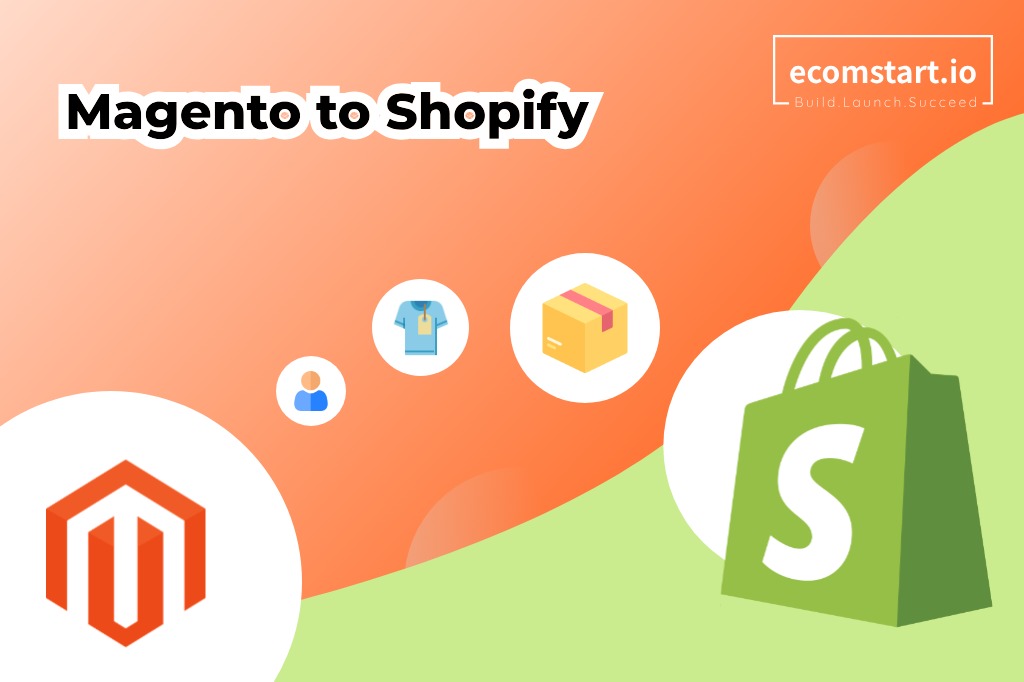
Migrating from Magento to Shopify can simplify your life, save you money, and help your business thrive in the highly competitive eCommerce landscape.
Chances that you’ve been rocking your online store on Magento for a while now, but you’ve started wondering if there’s a better platform out there. One that’s easier to manage, more user-friendly, and has some killer features to boost your sales. Many eCommerce entrepreneurs are considering the move from Magento to Shopify, and for good reason.
Before you delve into the migration process, it’s essential to have a clear plan in place. Therefore, this article will explore the Magento vs Shopify differences, as well as why you should migrate from Magento to Shopify, its cost, how to do that, and so on.
1. What is Magento to Shopify migration
Magento to Shopify migration is the process of transferring data products in the store – orders, customer information, for example – from Magento to Shopify.
It signifies that the data from an existing Magento store is exported and imported into a newly created Shopify store.
Magento, formerly known as Adobe Commerce, is an open-source eCommerce platform that is great for larger businesses with complex needs and a dedicated tech team to handle it all. All that flexibility and free-to-customize features require technology knowledge and coding skills.
You relied on Magento as your familiar and trustworthy house, but Shopify might be what you have been looking for all this time – the new comfortable, and promising new place. At your new house – or your new Shopify store – you’ll need to set up the layout, design, add your products, and configure all the necessary settings in Shopify.
Migrate products from Magento to Shopify or migrate orders from Magento to Shopify, or any possible data transfer can be done by yourself. Or you can look for some professional data migration third-party tools and apps. They will guide you through the process and ensure no hiccups occur.
2. Why move from Magento to Shopify
2.1. Shopify is more approachable
Shopify is a multichannel selling platform that connects through its integration functionality. Using Magento, this trait is something that can only be accessed by installing extensions.
As reported by Builtwit, in 2023, the most widely used eCommerce platform is Shopify with a usage rate of 27%. Shopify quickly becomes the first go-to name for many when discussions move toward business-focused eCommerce platforms.
2.2. Shopify is easier to use
Selecting a platform that is not easy to use will prevent you from getting the eCommerce store you envisioned. Shopify is much more user-friendly and easy to use than Magento. Compared to Shopify, the learning curve with Magento is quite steep.
Though Magento allows you to customize your online store in whatever way you desire, it requires coding and advanced technology skills. You will need to decipher jargon and code to construct the online shop that you would like, or hire a web developer to build the store for you.
2.3. Shopify has better support
Shopify has excellent support service that is available 24/7, and responsiveness via many means of requests. Those supports include email, phone, live chat, community forum, help center, tutorials, and even advanced specialists if required.
On the other hand, Magento – as an open-source platform – is aimed at professional web developers, or medium to large businesses. Magento has help and support for its users in the form of a User Guide in the Help Center. Live Chat is only available as an extension.
Though the quality of its user guides is extremely high and comprehensive, a non-tech-savvy can not expect to have an issue immediately addressed. Instead, they have to most likely solve it themselves.
2.4. Shopify is more affordable
It’s worth noting that Magento is aimed at enterprise-sized businesses. Unlike Shopify which has fixed pricing plans, Magento’s true cost will vary massively. For example, Magento extensions and themes can cost thousands of dollars each, depending on the web development agency that created them. Therefore, startups or small businesses often find that Magento is too pricey for their budgets.
3. Magento to Shopify migration: The checklist
Prepare your Magento store:
- Assess your current Magento store
- Backup data in your store
- Export data to a CSV file
Prepare your Shopify store:
- Register
- Select a subscription plan
- Set up your Shopify store
- Import data from Magento into Shopify
After the migration:
- Test your new store
- Launch your Shopify store
- Continue monitoring your store
4. How much does it cost to migrate from Magento to Shopify?
The total cost to migrate Magento to Shopify depends on different factors. For instance, your business’ size and scaling potential, your budget and expectations, etc.
4.1. Shopify subscription cost
This is the first cost that you face when deciding to migrate to Shopify. Shopify’s pricing ranges from $25/month to $399/month. Hence, research the pricing plans carefully and choose one that best suits your business depending on its size and needs.
4.2. Data migration cost
Approximate cost of hiring an expert to perform the migration:
- $500 to upwards of $42,000 per project
- About $50 – $80 or more per hour
Data migration tools’ average costs:
Some of the popular Shopify migration tools include Cart2Cart, LitExtension, and Matrixify. They are available right from the Shopify App Store. All of these tools offer a free demo migration so you can try before buying.
The price of a data migration tool is from several hundred to thousands of dollars, depending on the selected tool and on how much data needs to be moved. Not to mention other extent charges.
4.3. Shopify store’s setting up cost
The expenses will include theme costs and app fees (for functionalities).
Average pricing for Shopify themes:
Shopify provides more than 170 free & premium themes, typically priced between $180 and $350.
Average pricing for Shopify apps:
The Shopify app store offers a selection of over 8000 free & premium apps. On average, it might cost about $20 per month as you pay for the premium apps on the Shopify platform.
5. What data can you migrate from Magento to Shopify
Products:
- Name, SKU, description, status, manufacturer
- Price, special price, URL, meta title, meta description
- Product images, product tags
- Weight, variants, quantity, manage stock
Product categories:
- Name, description, status, image
- Meta description, meta title
Customers:
- First name, Last name, Email
- Billing & Shipping addresses
Orders:
- Order date, status, order product info
- Shipping addresses
- Customer names, email, billing addresses
Other data:
- Coupons, reviews
- CMS pages, languages
- Manufacturer, tax
6. What you cannot migrate from Magento to Shopify
- Magento-specific elements: Custom extensions, theme, multi-store setup, and store credits
- Blogs pages
- Customer passwords
- Discounts
7. How to Migrate from Magento to Shopify
7.1. Step 1: Backup & clean your data
The first step of moving from Magento to Shopify involved backing up your Magento store. Everything has a backup plan, and so does your precious data. This will avoid data losses if errors occur during the migration process.
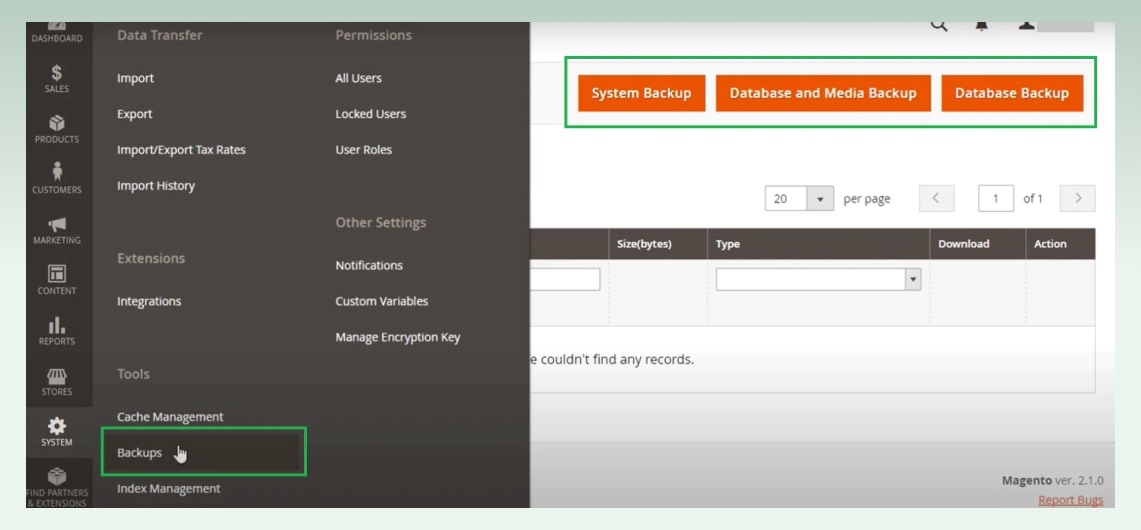
- On your Magento admin dashboard, click on System > Tools > Backups
- Choose your backup type and name your backup for easier access.
System Backup: backup the entire system, including your source code and the database.
Database and Media Backup: sync only content from the database and media folder. Other elements such as the store themes are not backed up using this restore.
Database Backup: save your store’s database only.
- To exclude the media folder during the backup process, check on the box next to “Exclude media folder backup.”
- Click OK to confirm this action. The maintenance mode is automatically turned off when the backup process ends.
7.2. Step 2: Set up your Shopify store
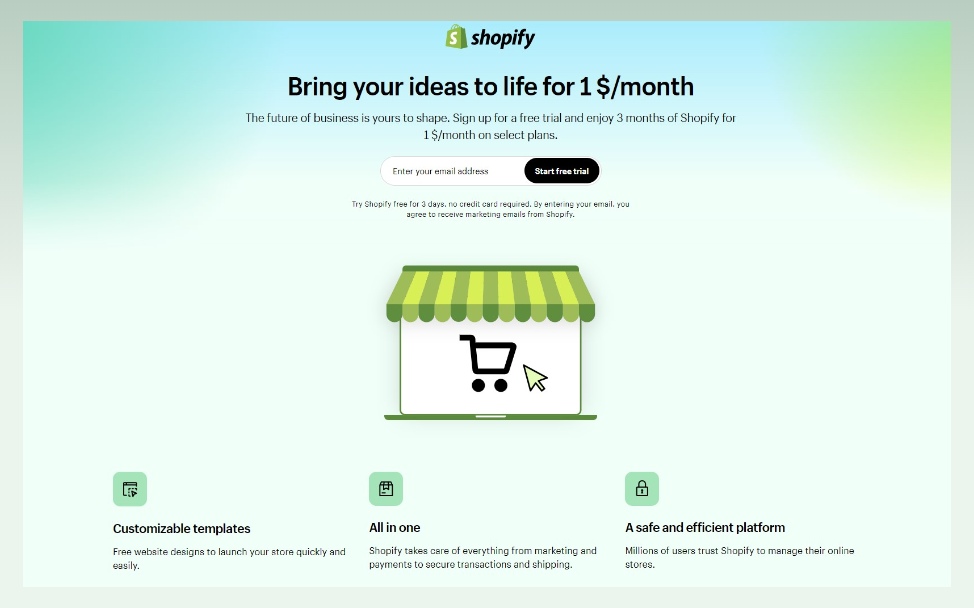
To start building your store, first, you need to register for an account in Shopify. It will require just your email address and some basic information about your business – the industry that you operate in, how much money your company makes, your business register status, etc. Completing this step will take a couple of minutes.
7.2.1. Choosing a subscription plan
Shopify offers a 3-day free trial and charges $1 for the next three months. Reasonable time and cost for even startups or small businesses to test the platform thoroughly.
Anyway, to begin with selling on Shopify properly, you will need to choose a subscription plan. As for now, Shopify provides 3 fixed pricing plans, which will slightly vary depending on whether you pay monthly or annually.
When choosing a pricing plan, consider your store’s budget, sale volume, inventory, scalable potential, required features, and level of support it needs. Not to mention you may need to pay for apps, themes, or plugins while operating your store.
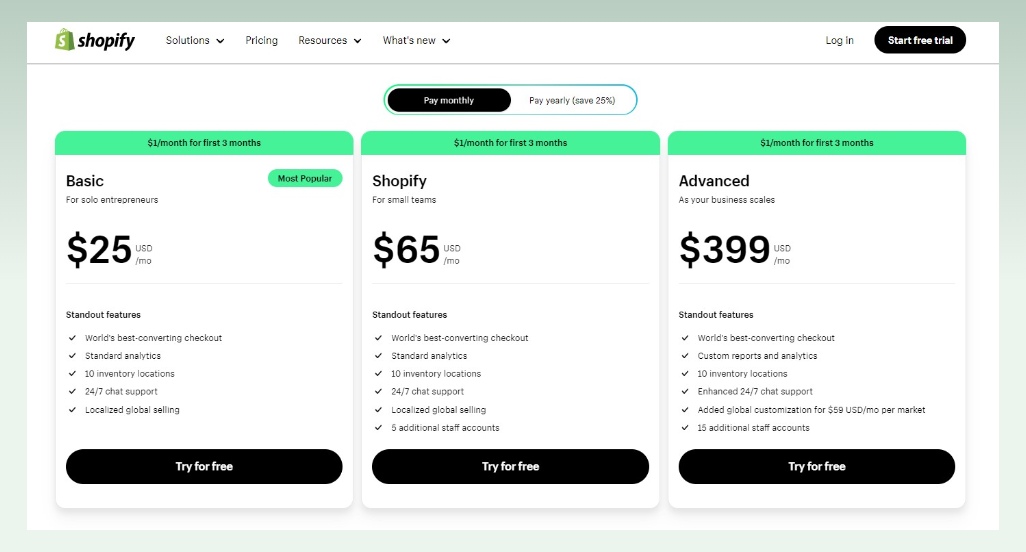
7.2.1. Select a theme
Shopify provides you with a variety of both free and paid themes. When just installing your store, it will include by default the Dawn theme. Nevertheless, you might explore other free and paid themes to select a Shopify theme that aligns with your brand.
To check out all themes available in the Shopify theme store, you need to access the Shopify admin and select Online Store > Themes. Next, just scroll down a little and you’ll find other sections titled – Popular free themes and Explore more themes.
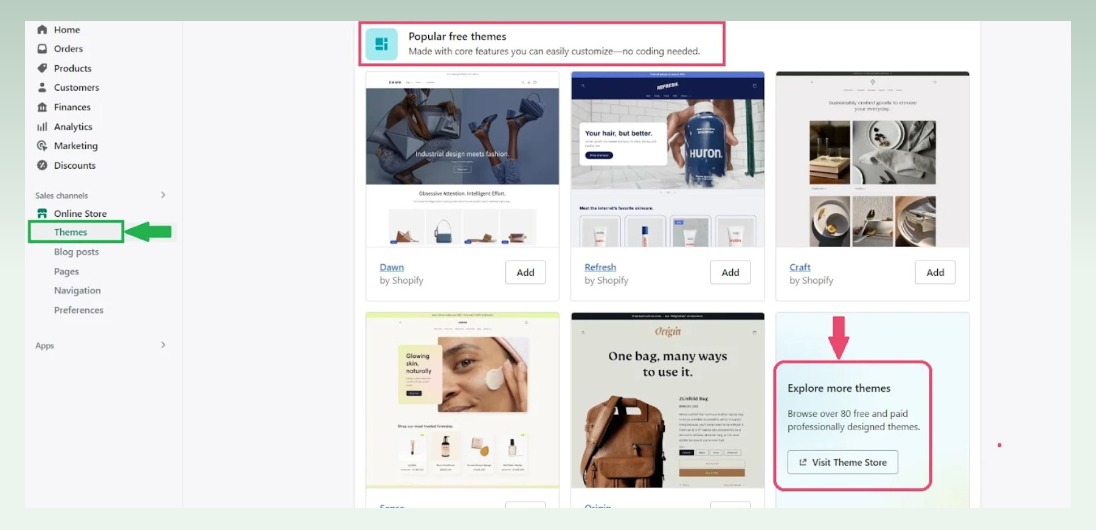
7.2.3. Setup payment gateways
- In the Shopify admin dashboard, navigate to Settings, and click on Payments
- Select the payment provider that will be integrated into your online store. If you are qualified to use Shopify Payments, you will find the ‘Activate Shopify Payments‘ button.
- When you click on the Activate Shopify Payments, enter the required information and follow the steps given under ‘Complete account setup’
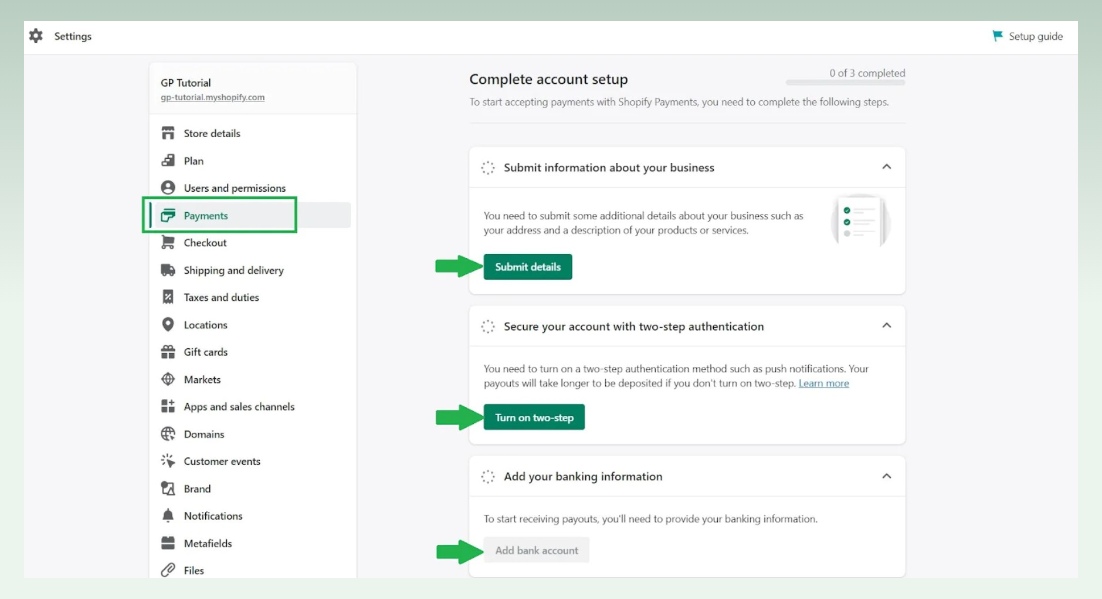
- For other payment providers, go through the setup processes to select and activate them.
7.3. Step 3: Export data from Magento to Shopify
- Log into your Magento admin and select System > Data Transfer > Export
- Enter the Entity Type (Products) and select the Export File Format: CSV for the export of your product data
- Perform the same steps for the Customer Main File and Customer Addresses to create CSV files of export data. When finished, you will have CSV files ready to be imported into your Shopify store
7.4. Step 4: Import data from Magento to Shopify
7.4.1. Using a CSV File

- Upload a CSV file on Shopify to perform bulk uploading of products. You can download a sample CSV format from Shopify and use it to rearrange your CSV document
- After your data is prepared and ready in the CSV file, click on the ‘Add file option’ under the ‘Import products by CSV’ section
- Keep the checkbox ‘Overwrite any current products that have the same handle. Existing values will be used for any missing columns’ unchecked
- Press ‘Upload and continue’ to import your data. The setup might take some time, depending on how much data you import
7.4.2. Using an app
Magento to Shopify data migration can be done by using third-party importer apps available in the Shopify App Store. The data will be automatically imported. Choose a suitable Magento to Shopify migration app, install it, select the entities that you would like to migrate, and they will do all the rest of it.
There are some apps and tools for importing data to your Shopify store – LitExtension, Cart2Cart, Matrixify, etc.
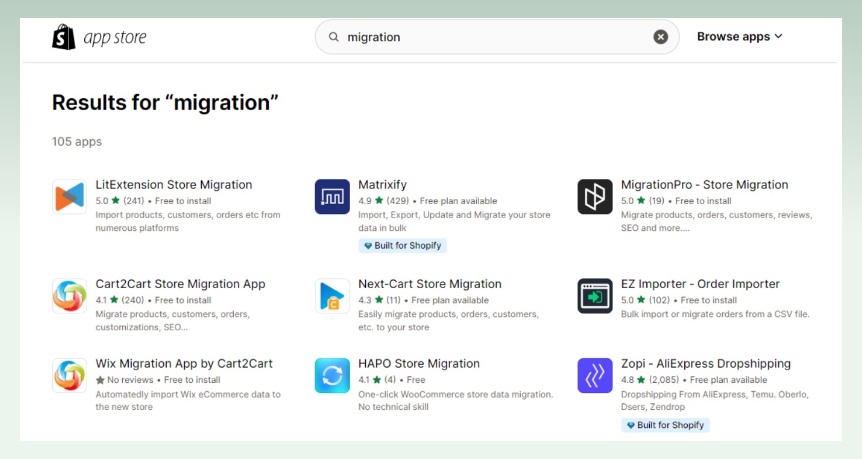
7.5. Step 5: Test & launch your store
After you have imported the information and configured your Shopify shop, you should review and analyze the whole store. Moreover, do not forget to perform the testing of your store’s functionality every once in a while by placing several test orders.
The aim is to assess and confirm that order processing flow, email notifications, payment gateway, checkout procedure, and Shopify apps work as planned. After all this is done, you can remove the store’s password protection and have your Shopify store fully launched
You can email your customers about the change in platform and guide them on how to create new customer accounts. Additionally, it would be useful to mention page redirects and any unavailable services during the migration.
8. Tips for smooth migration
Here are a few more things to do for the Magento to Shopify migration process to be successful.
8.1. Set up 301 redirects
During the transition from Magento to Shopify, you must pay attention to managing URL redirects and structures. Therefore, your store’s search engine rankings won’t drop, which could hurt users’ experience. A 301 redirect also guarantees that search engines and visitors will avoid seeing a “ Page Not Found” or “404 Error”.
You will not have to be concerned about losing organic traffic and reach. Regularly update your meta tags, descriptions, and structured data for the most visible search engine exposure.
8.2. Optimized SEO
You should research keywords to find the right keywords for your target customers and markets. Then, rewrite the URLs, meta titles, and descriptions for your pages and products. Don’t forget to use SEO-supported apps and tools.
8.3. Migrate blog content
Your organic traffic is enhanced partly by blog posts or social content. Hence, ensure that they end up in your new Shopify store and offer benefits for the users and search engines. No feature from Shopify allows a page and blog post to be natively imported into the platform. You will need a third-party app, which you can find on the Shopify App Store
8.4. Continuously monitor your store
First, you need to connect your old Magento domain to the Shopify store. One thing to take into consideration is to unlock the domain before you move it. Then, keep a close eye on the performance measures of your new Shopify store, such as how fast it loads and how quickly the server responds.
9. Common errors and solutions
9.1. Importing issues
Shopify lets you import data straight into your store via the admin dashboard. Nevertheless, it is not possible to import some data types such as customer passwords, blog content, or purchase histories in that method. As an alternative, you should import them via a third-party application or Shopify’s API.
9.2. Customer passwords not importing
Importing your customer passwords into Shopify is impossible due to their encryption. There are two solutions. You would either have to send an invitation via email to your existing customers, so they can re-activate their accounts by choosing a new password. Or you can rely on another third-party app from the Shopify App Store.
9.3. App incompatibility
These are some of the issues that might surface at any point in a migration process. Indeed, some of your Magento apps may be incompatible with Shopify, since those applications and extensions are designed by numerous developers. This risk that upon installing and using an application, malfunction will take place.
Therefore, make sure that you visit the Shopify App Store and look for compatible Shopify apps that are similar to the ones in your Magento store.
9.4. Lengthy data import process
One of the most common problems is that it takes a quite long period to import your data into Shopify. The process may take seconds up to hours or days based on both the volume of your data and your internet connection speed.
The migration process can be quite straightforward if you have a small store with little customization. On the contrary, large stores may need much more technical competency and efforts to be efficiently migrated. That’s why we recommend you notify your customers about the downtime of your website.
10. Conclusion
The above guides should hopefully have covered all you need to know about switching from Magento to Shopify. Shopify is scalable, provides businesses with an attractive online storefront, and is easy to navigate and personalize. Before moving from Magento to Shopify, it is always a good idea to create a backup of your current Magento store data to avoid any data losses that could occur.
If you are still unsure about making the transition from another platform to Shopify for your online store, then there is eComStart.io to help out with that problem. eComStart will not just walk you through a full-scale migration, but also provide helpful business guides.


